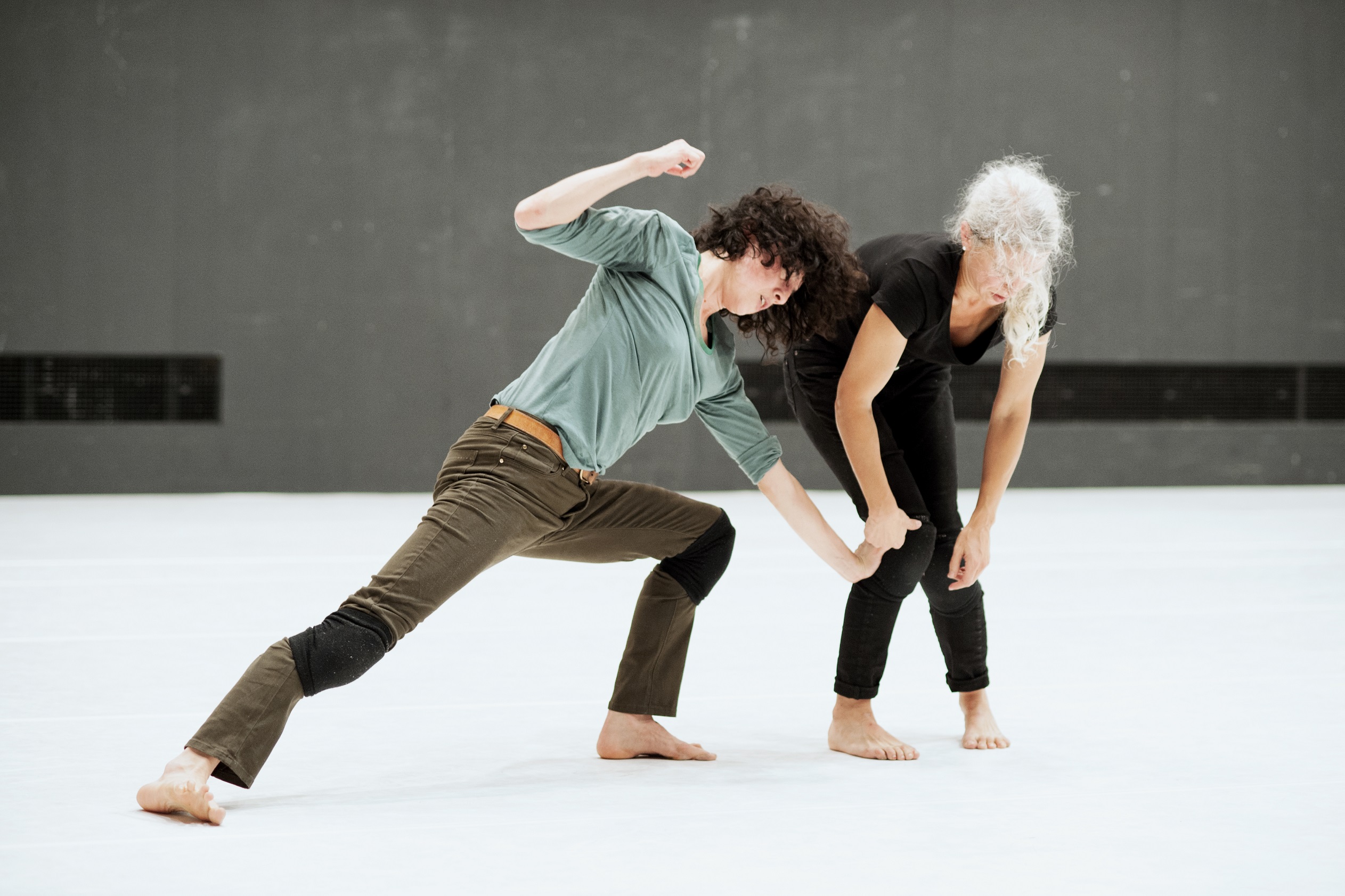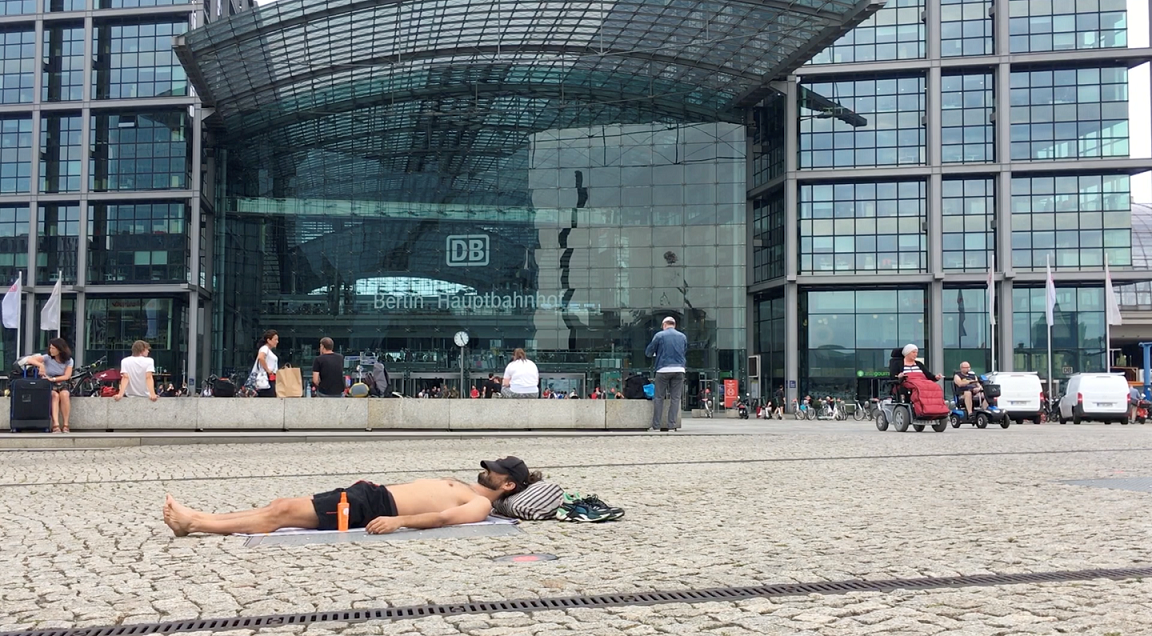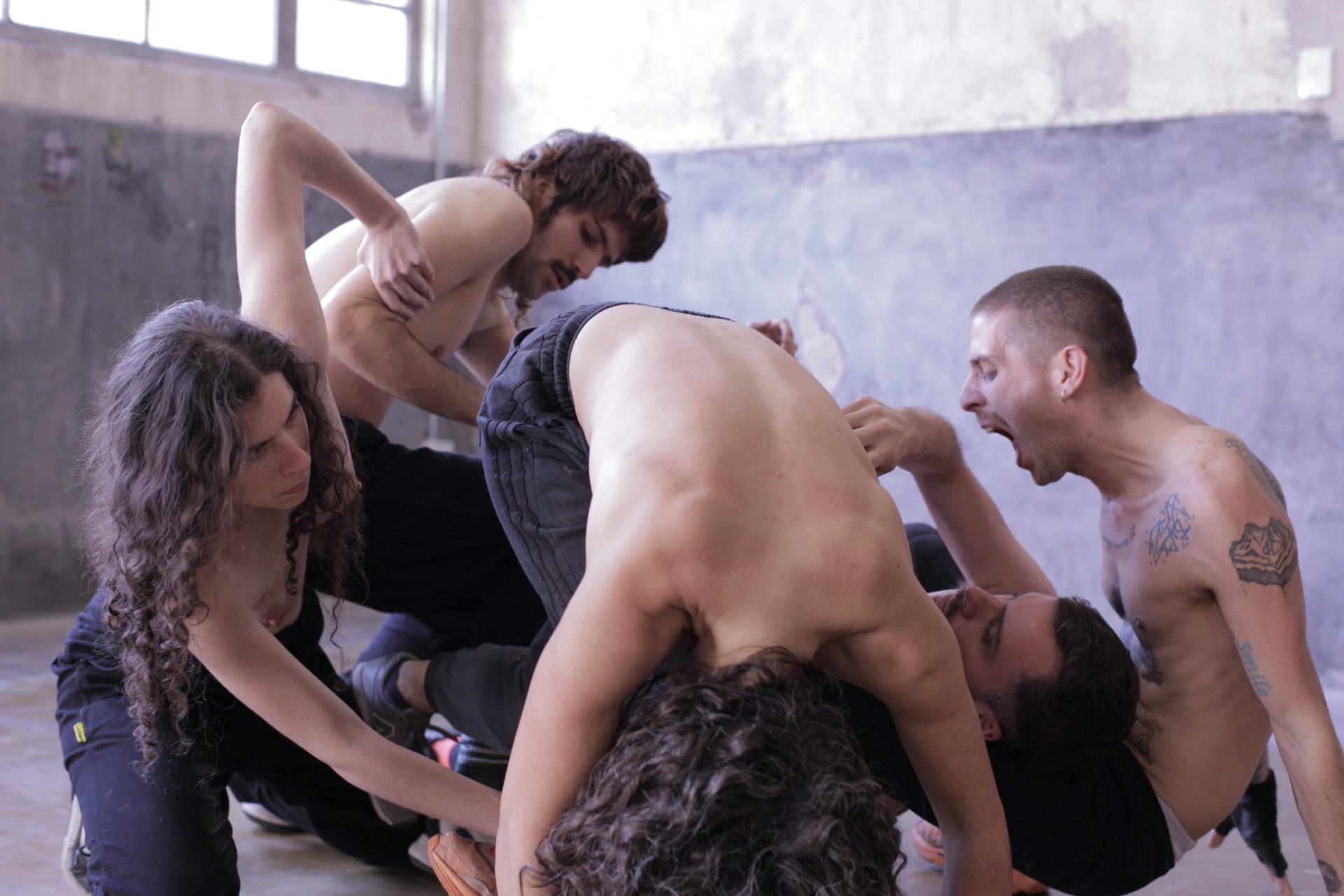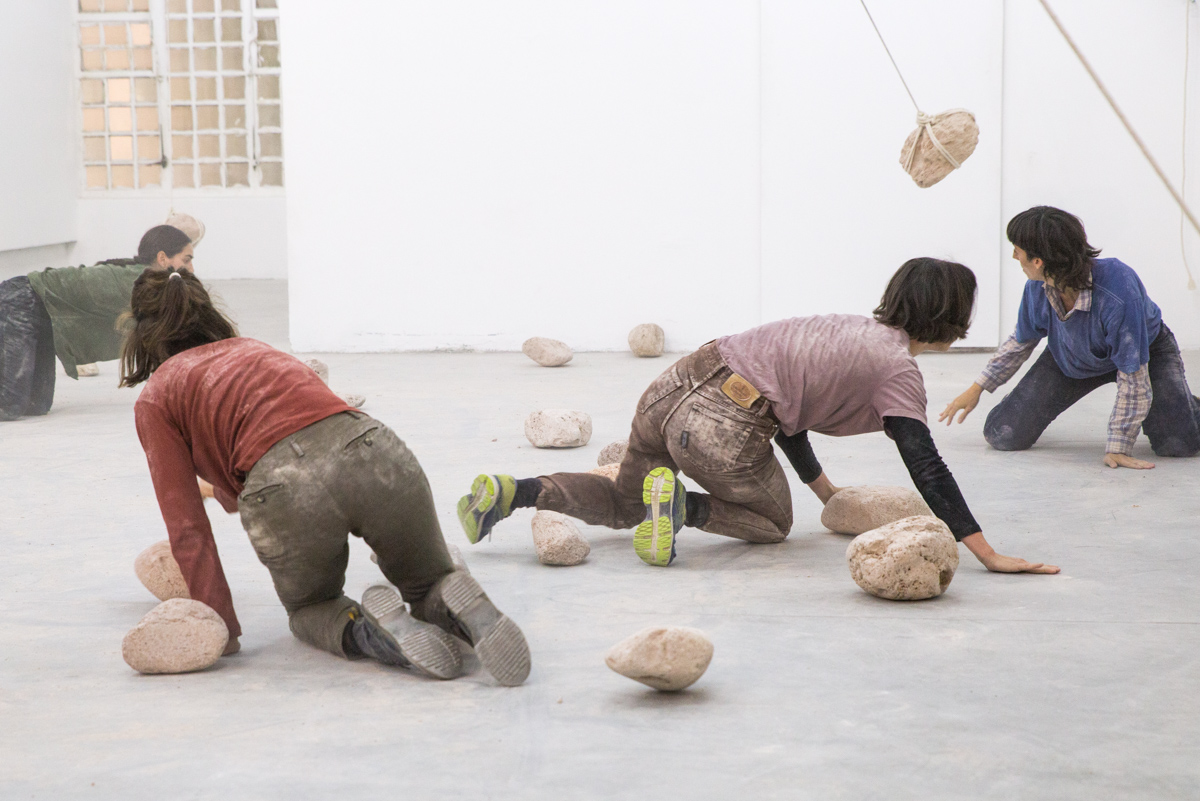A new project emerges from a long period of living with a set of impressions, intuitions and interests—both the conscious and the unconscious work together to give meaning to something on a conceptual level. I am interested in a certain thing without really knowing why; in everyday life, sensations lead me to it: little by little, a sufficiently clear idea-concept emerges that mobilizes all these feelings and ideas. Likewise, part of my artistic practice is to go to the studio to move freely, to physicalize certain interests, sometimes to read and then to dance, without a concrete idea. Therefore, sometimes the mobilizing concepts are not only the product of an intellectual work based on readings and thoughts, but they are also the result of operations, performative tasks, and logics of doing and movement.
Bodies as Sensitive Territories
04/14/2023
Dancer, choreographer and researcher of the body in movement, Varinia Canto Vila (Santiago de Chile, 1976) addresses in her practice the notion of extended choreography and the organization of the movement of the social body in pedagogical contexts.
These themes are manifested in pieces and exercises that allow for the sharing of materiality, choreography as a system of organization, and politics, thus allowing for collaborative interpretations. She is currently developing Maneras de Salir with the support of Nave and Centro Cultural Gabriela Mistral, a piece that tries to generate worlds and places within the scene through different explorations of the notion of cartographies.
Education
Training
My beginnings as an artist were rather late and gradual. While studying contemporary dance at the Conservatory, I became interested in creating short solos as exercises in personal expression. In my 20s, I began to see creation as a reflexive practice in which form and content generate concepts and operations of creation and composition. A decade later, I dared to apply for funding and produce my works.
The reflexive practice of creation that I developed while dancing in the projects of other choreographers is an activity that still interests me and that I continue to actively desire and carry out.
Moreover, I belong to a world of contemporary dance that considers the dancer as an artist: they practice from authorship, propose ideas and develop their own language within the framework of a choreographer's creation. It is under this profile that I identify myself when I collaborate with other choreographers or artists.

Teaching
The pedagogical practice is not my main practice, but I do facilitate labs and workshops that try to propose ideas to think about and explore through doing. I do not usually teach methods and knowledge established by neither the academy or contemporary dance techniques in general.
My pedagogical practice is based more on sharing interests and questions, facilitating and proposing ways of doing, and hoping to inspire others, and in this sense I believe that both giving and receiving pedagogical practices is a good way to put individual practices into perspective, to encourage them to be seen from a different angle, from a common context. This makes it possible to recognize oneself "outside" oneself and thus to feel the strangeness of what one does, which allows one to come closer and "find oneself" again.
I also believe that if we define education as the practice of transmitting and generating knowledge, then I believe that experiencing an artwork is an educational experience in itself.




Learning
Thanks to a filmmaking partner I had between the ages of 20 and 28, I had a lot of access to auteur cinema. Through this experience, I realized that both dance and film are arts that work over time. I also learned a lot from Goddard, especially about how to convey content through form. For example, I think Goddard's cinematic language not only questions the conventions by which cinema has been built (especially by Hollywood), but also offers ways to question the way we generate content from the relationship between image and sound. There are also many passages in his work where the actors develop ideas through very performative strategies. These three things taught me to look at content from a more abstract and less narrative perspective in the use of linear time. Goddard's strategies gave me confidence in the concept and how to materialize it in terms of choreographic work. I think Goddard has shaped many colleagues of my generation, giving us tools that elicit the freedom to be playful and humorous.
On the other hand, I also learned a lot from Xavier Le Roy's solos. Self Unfinished, a work I saw as soon as it was created in the 2000s, particularly impressed me because it taught me to consider the gaze and perception as important components in the experience of a work of art. In his solo Untitled, I also felt that perception is treated as a cognitive phenomenon; beyond treating it as an opportunity for pyrotechnics and visual tricks, Le Roy explores it in its raw state, as close as possible to bodily experience. For me, his work is a kind of philosophical essay on the body, the scene, and the gaze. There is no spectacle in his work, only questions, and I find that very beautiful.
Processes
Beginnings
Questions
I believe that doubt, error, intuition, and contingency are extremely important in any process, be it conceptualization and/or formalization. I wouldn't know exactly what role they play, I don't think I've reached a level of awareness of my practice yet to know that. I think at the moment I am just doing and have not done enough to be able to analyze trends in my work. However, I think that doubt, error, intuition, and contingency are concepts that can interfere a lot with the creator's ego, which creates fear of them as well as distrust of intuition. So what I know now, at 47 years old, is that I am more at peace with myself than I was when I was 30, and that is why these notions can coexist in the processes, because they do not scare me (as much) anymore, and they teach me a lot about where to look, when to stop looking, and how to take care of what is generated.

Strategies
I don't have a clear idea of how to organize my work methodically. I don't know if I still understand very well what a method is, and in a certain way, when I have worked around a method, the creative work has been transformed around it, often leaving the content aside. So I think I can say that I am not a method artist. Even when I work alone, I often think that what organizes my work sessions is not to get bored with the experience of exploration and study, and it is not that I am looking for entertainment, but I think that feeling interested in something is undoubtedly about feeling alive and surprised by what I am doing. So I think that in this desire to vibrate, the methodical comes second... Perhaps I could say that what I do as a method is to read again, to do again, to look again, as a form of over-writing, to be able to refine and direct the work towards a more thoughtful side.
Procedures
In my creations i often use the score as a tool. If I were to try to define it in my own words, a score would be a logic of doing and thinking that gives certain rules of operation and leaves free space for the decisions of the one who makes it. A score allows those who make it to interpret it and to operate with their own artistic choices. In this way, there is always an important degree of collaboration in the creation, where the other dancers/performers are always creative artists or co-creators. The use of the score in dance and performance creations is very common nowadays, and in this sense my work fits into a very current tradition of collaboration that many colleagues are working from.
Therefore, when I participate as a dancer in other projects, I choose only those projects where the method is through score-like tools, because in this way I make sure that my role is as a co-creator and not as a mere interpreter.
Dialogues
In general, the people involved in my projects so far have been dancers/performers, light and sound designers, and playwrights. To each of them I communicate the idea, the concept I'm working on and the way I'm working on it. The dancers/performers are the ones who are most involved in the work from the beginning. I always try to work on my own first to understand and study what I am interested in researching, so that when the time comes to work with the dancers-performers, I already have ideas and suggestions for work tasks, such as research dynamics in the making through the use of score, which are never forms to be imitated or learned. It is important to me that the dancers/performers who work with me feel creatively and intellectually stimulated; I do not always achieve this (because sometimes not everyone is as interested in what I am interested in), because what I look for is that the dancers/performers are people and creators in the projects and works and not dancers/performers per se. I try to see them as people and not as executors of my ideas.
Works and Projects
In progress
I am currently finalizing a choreographic work called Maneras de Salir, which I am developing together with three fellow Chilean dancer-performers: Poly Rodriguez and Rodrigo Chaverini. It is a work that emerges from the political and social experience that I lived during my return to Chile after 24 years of living abroad. Since my return in June 2019, I have not only had to live the social outbreak and the current constituent process, but I have also been confronted with a highly codified and encoded society, the product of a very deep economic inequality that generates very violent social and economic injustices, both at the structural level and at the interpersonal level.
The experience of the Chilean reality, after 24 years of living in Belgium, where I experienced what it means to live in the conditions of a generalized middle class, made me think of Chile or Santiago as a society made up of a thousand maps of positionings, which means that in our daily lives we constantly feel that we relate to the other from a code or position, while we feel that the other also places us in a map of code or position. So in this work I develop the notion of cartographies through choreography, of a thousand maps superimposed like a thousand leaves.
In perspective
When I look at the works I've made, I see that there are three very different themes that continue to interest me: materiality, choreography as a system of organization, and politics. Every work I have made has touched on these three themes, or rather territories of exploitation and operation, but in different orders of priority and intensity. The relationship between these three themes became more evident in my choreographic work by getting one's hands dirty, which I produced in 2017 together with the performer, artist, and teacher Lilia Mestre; since that work, I feel that I continue to explore the same sensitive territories, but with different questions and also with greater clarity about my artistic practice. Also, with each creation I enjoy more and more what I do, from its pains, difficulties and joys.

Contexts
Without wanting to, as Chavo del 8 says, I think I am a person who vibrates a lot with social and political issues. My biography is crossed by important political events, from the flight from the Pinochet regime with my family, the exile, then the migration and the experience of returning to Chile, all these moments of my life have crossed me from a political point of view. This led me to study political science and sociology as an amateur (I enrolled in the university without graduating, because I did it out of pure interest).
So, reading the contexts, the way in which cultures live public spaces and the political is a recurring theme that I am very interested in talking about with my friends and family. There is no doubt that because I am so sensitive to these dimensions of existence, my work is permeated by all these observations and questions.

